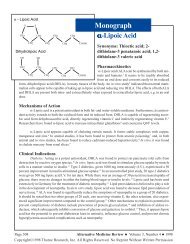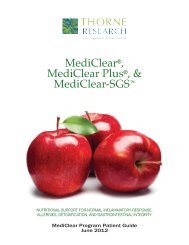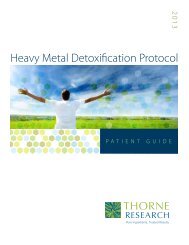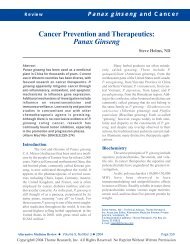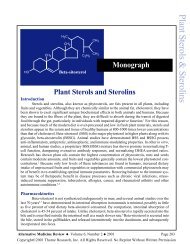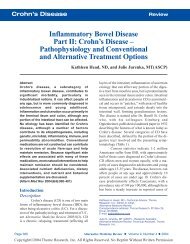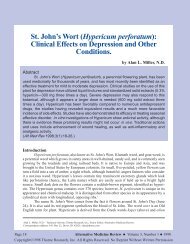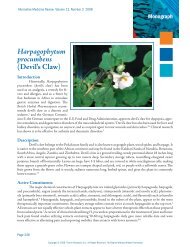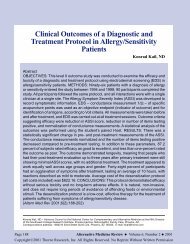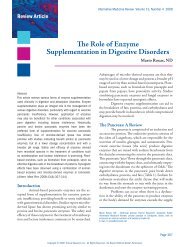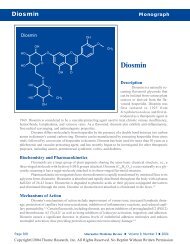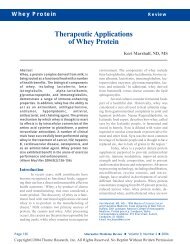Create successful ePaper yourself
Turn your PDF publications into a flip-book with our unique Google optimized e-Paper software.
<strong>Wound</strong> <strong>Healing</strong> Review<br />
a diet deficient in protein, vitamins, or minerals.<br />
In addition, increased metabolic demands are<br />
made by the inflammation and cellular activity in<br />
the healing wound, which may require increased<br />
protein or amino acids, vitamins, and minerals. 2<br />
The objective in wound management is<br />
to heal the wound in the shortest time possible,<br />
with minimal pain, discomfort, and scarring to the<br />
patient. At the site of wound closure a flexible and<br />
fine scar with high tensile strength is desired.<br />
Understanding the healing process and nutritional<br />
influences on wound outcome is critical to successful<br />
management of wound patients. <strong>Research</strong>ers<br />
who have explored the complex dynamics of<br />
tissue repair have identified several nutritional<br />
cofactors involved in tissue regeneration, including<br />
vitamins A, C, and E, zinc, arginine, glutamine,<br />
and glucosamine. Botanical extracts from Aloe<br />
vera, Centella asiatica, and the enzyme bromelain<br />
from pineapple have also been shown to improve<br />
healing time and wound outcome. Eclectic<br />
therapies, including topical application of honey,<br />
sugar, sugar paste, or Calendula succus to open<br />
wounds, and comfrey poultices and hydrotherapy<br />
to closed wounds are still in use today. Although<br />
anecdotal reports support the efficacy of these<br />
eclectic therapies, scientific evidence is lacking.<br />
The Four Phases of <strong>Wound</strong> <strong>Healing</strong><br />
Tissue injury initiates a response that first<br />
clears the wound of devitalized tissue and foreign<br />
material, setting the stage for subsequent tissue<br />
healing and regeneration. The initial vascular response<br />
involves a brief and transient period of<br />
vasoconstriction and hemostasis. A 5-10 minute<br />
period of intense vasoconstriction is followed by<br />
active vasodilation accompanied by an increase<br />
in capillary permeability. Platelets aggregated<br />
within a fibrin clot secrete a variety of growth factors<br />
and cytokines that set the stage for an orderly<br />
series of events leading to tissue repair.<br />
The second phase of wound healing, the<br />
inflammatory phase, presents itself as erythema,<br />
swelling, and warmth, and is often associated with<br />
pain. The inflammatory response increases<br />
vascular permeability, resulting in migration of<br />
neutrophils and monocytes into the surrounding<br />
tissue. The neutrophils engulf debris and<br />
microorganisms, providing the first line of defense<br />
against infection. Neutrophil migration ceases<br />
after the first few days post-injury if the wound is<br />
not contaminated. If this acute inflammatory phase<br />
persists, due to wound hypoxia, infection,<br />
nutritional deficiencies, medication use, or other<br />
factors related to the patient’s immune response,<br />
it can interfere with the late inflammatory phase. 3<br />
In the late inflammatory phase, monocytes<br />
converted in the tissue to macrophages, which digest<br />
and kill bacterial pathogens, scavenge tissue<br />
debris and destroy remaining neutrophils. Macrophages<br />
begin the transition from wound inflammation<br />
to wound repair by secreting a variety of<br />
chemotactic and growth factors that stimulate cell<br />
migration, proliferation, and formation of the tissue<br />
matrix.<br />
The subsequent proliferative phase is<br />
dominated by the formation of granulation tissue<br />
and epithelialization. Its duration is dependent on<br />
the size of the wound. Chemotactic and growth<br />
factors released from platelets and macrophages<br />
stimulate the migration and activation of wound<br />
fibroblasts that produce a variety of substances<br />
essential to wound repair, including glycosaminoglycans<br />
(mainly hyaluronic acid, chondroitin-<br />
4-sulfate, dermatan sulfate, and heparan sulfate)<br />
and collagen. 2 These form an amorphous, gel-like<br />
connective tissue matrix necessary for cell migration.<br />
New capillary growth must accompany<br />
the advancing fibroblasts into the wound to provide<br />
metabolic needs. Collagen synthesis and<br />
cross-linkage is responsible for vascular integrity<br />
and strength of new capillary beds. Improper<br />
cross-linkage of collagen fibers has been responsible<br />
for nonspecific post-operative bleeding in<br />
patients with normal coagulation parameters. 4<br />
Early in the proliferation phase fibroblast activity<br />
is limited to cellular replication and migration.<br />
Around the third day after wounding the growing<br />
mass of fibroblast cells begin to synthesize and<br />
secrete measurable amounts of collagen. Collagen<br />
levels rise continually for approximately three<br />
weeks. The amount of collagen secreted during<br />
this period determines the tensile strength of the<br />
wound.<br />
Page 360 Alternative Medicine Review ◆ Volume 8, Number 4 ◆ 2003



